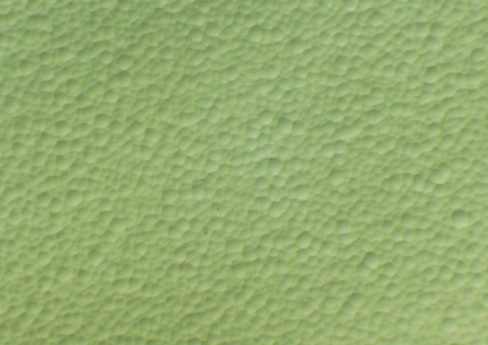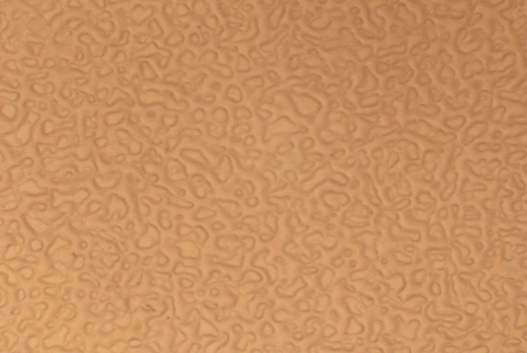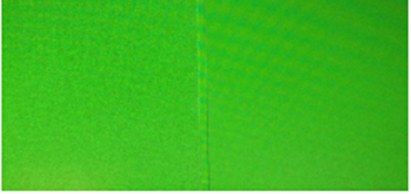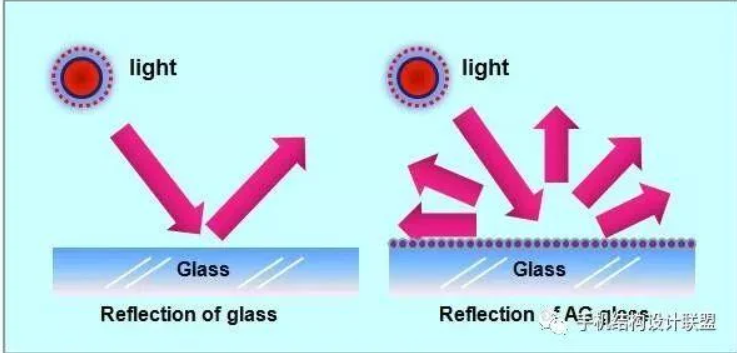All Info Share
-
什麼是AG玻璃?
Anti-glare 中文防眩光,通過對表面進行微細凹凸加工,防止光直射入眼睛,從而有效減少眩光和反射,其特點是使原玻璃反光表面變為啞光無反射表面(表面凹凸不平),其原理是把優質玻璃片的雙面或單面經過特殊加工處理。使其與普通玻璃相比較具有較低的反射比,光的反射率由8%降低到1%以下,用技術創造出清晰透明的視覺效果,讓觀賞者能體驗到更佳的感官視覺,可提高LCD(液晶顯示器)的顯示效果;主要原理:通過光的散射和漫反射作用,降低反射而達到防眩暈,防刺眼的目的,以創造清晰透明的視覺空間,從而有更佳的視覺享受。
.png)
-
AG玻璃的加工種類
AG玻璃加工種類一般分成三種:化學蝕刻AG、噴塗AG、噴砂AG
噴塗AG:顧名思義噴塗AG就是通過噴塗設備噴到玻璃表面,在玻璃表面附著一層塗層來達到防眩光的效果。噴塗通過噴槍或碟式霧化器,借助於壓力或離心力,分散成均勻而微細的霧滴,施塗於玻璃表面的塗裝方法。其優點是這種加工工藝方便和快捷,生產效率較高,可以很方便的加工出不同光澤度和霧度值AG玻璃產品,所以在AG玻璃市場還是佔有一定的份額。
但是噴塗AG的劣勢在哪呢?噴塗AG難在AG玻璃常規檢測的光澤度和粗糙度上做很大明顯的調整,因環境與使用因素會造成AG層剝落 (通常需求較嚴格的終端客戶會額外要求提出物理及化學測試報告),另外AG表面的耐磨擦性能,用鋼絲小球摩擦測試只有2500~4856次,大概就是5000次左右。這個相對化學蝕刻AG最少相差了2~3倍。
雖然蝕刻AG的特性較傳統噴塗及噴砂AG強壯許多,但對玻璃母板來料品質的要求卻是較其他兩者更為嚴格,因等向蝕刻製程特性,將使原來母板的缺陷放大3~5倍,例:母板廠商提供的缺陷規格為100um以內即為合規品可出貨,而實際某缺陷大小為50um, 蝕刻製程後該點缺陷將放大至少到150um,更容易被人眼外觀檢驗檢測出來,甚至於無法符合某些較嚴格的出貨規範。
噴砂AG:噴砂AG 玻璃就是機械噴砂工藝來實現,機械噴砂是通過細微顆粒的陶瓷珠為介質,通過噴砂機產生的壓力噴射在玻璃表面,以此對其打磨的一種工藝。噴砂工藝是一種比較成熟的工藝,通過變更介質材質及尺寸,來控制被加工表面的粗糙度,表面處理工藝細微。噴砂工藝優點是工藝及流程簡單,可以連續生產,效率較高,而且非常環保。缺點是噴砂處理工藝,造成玻璃容易破碎及崩邊。在家居及建築行業使用非常多,像辦公室幕牆、浴室、門窗等。
化學蝕刻AG玻璃:它是經過特殊的化學工藝處理製成,其特點是使原玻璃反光表面變為啞光漫反射表面。可使反光影響模糊,防止眩光以外還使反光度下降,減少光影。防眩產品表面防腐、防劃傷性能強。解決電子視屏、影像螢幕在環境光源下產生反光、眩光問題。蝕刻AG屬化學蝕刻,蝕刻深度 (粗糙度Ra) GCM技術能力為0.8~0.05 um之間,AG處理後表面本質仍為玻璃,物理、化學特性及產品壽命與強化玻璃相當,終端客戶一般不要求如噴塗AG一般另外提供物化相關測試報告。蝕刻AG還有什麼優勢呢? 蝕刻AG能做到的粗糙度、光澤度、透過率範圍較多:蝕刻AG粗糙度範圍能做到0.05-0.1um之間, 光澤度最高能做到GU145 (GCM能力), 透過率在90%以上(蝕刻AG不影響玻璃本身的透過率),規格種類搭配選擇多,在多重優勢下蝕刻AG未來將是中高端觸控式螢幕行業的首選。
蝕刻AG於OM下示意圖: 市面上許多號稱蝕刻AG,但事實上其抗眩功能並不如預期或是實際上非以蝕刻工藝製作,於OM下可明顯區分真正的所謂的蝕刻AG與非蝕刻AG/假AG的結構差異,左一為正常蝕刻結構,可清楚看見圈狀顆粒地形結構,右圖為僅浸泡過蝕刻液或以噴塗蝕刻製作的顯微鏡下Top view,未將蝕刻AG的地形結構特性蝕刻成形。


-
AG玻璃量測參數為何?
.png)
除上述可用儀器量測的參數外,另外尚有閃點 (Sparkling), 一種屬於主觀判定及認知的玻璃外觀視覺效果特性,閃點的需求高低很大因素取決於終端客戶的顯示技術,例如PPI解析度,也就是像素密度,通常數值越高代表顯示的圖像越精細。並非一定閃點低就一定是終端客戶需求的,需搭配終端客戶顯示規格及需求來選用適當閃點的玻璃。(如下圖左閃點較高, 右閃點較低),而目前市面上有動輒數百萬號稱能量測閃點的儀器,但經車載T1廠實測,尚未能真正完全強過人眼所判斷的閃點視效,故當客戶嚴格要求閃點特性時,建議訂立買賣方皆可接受的限度樣品做為未來生產閃點參考依據。GCM閃點判斷方式:Iphone 6s, 1334x750像素, 326ppi綠色背景, 裸眼觀察。

-
AG玻璃的光學參數與視覺效果的相關性
玻璃材料不同於半導體晶圓,半導體矽晶圓其參數與電性有著絕對的相關性,而玻璃卻不然,玻璃主要應用於外觀器件居多,終端客戶在選擇喜好的玻璃通常取決於視覺效果, 視覺效果的喜好很容易因客戶偏好及其後段顯示技術而異(主觀因素較強),以GCM的蝕刻AG製程能力,同樣GU80的光澤度條件,可以製作出至少3種不同的視覺效果 (如燈管反射較清晰, 中等清晰及模糊等視覺效果, 閃點特性及粗糙度亦不相同),故與終端客戶洽談AG需求時,務必確認客戶對於視覺效果的需求。
-
AG加工搭配其他玻璃加工程序問題
加工順序通常為:母板->AG蝕刻加工->化強->後續CNC/AR/AF/AS鍍膜加工。AG蝕刻加工會視母板大小、厚度及實際產品尺寸定義無效區。
-
蝕刻AG後玻璃厚度會變薄嗎?
是的,若終端客戶對最終玻璃厚度有需求限制,在蝕刻加工之前應慎選原始母板厚度規格,玻璃母板來料本身有厚度上下限差異,加上蝕刻減薄厚度都需要考量進去。例如:進料日本CG厚度1.8mm玻璃母板,原始來料規格書為1.8±0.10 (對CG母板商來說,合規格內就能出貨),但以CG大宗來料品質多數實際厚度偏下限介於1.72~1.76mm間,鮮少>1.78mm,若選擇AG加工GU80,燈管中等清晰模糊,Ra<0.15之製程,蝕刻後玻璃厚度將再減薄0.12~0.15mm, 則該批偏下限母材玻璃預估最終產品厚度範圍為:
最低1.595mm~最高1.655mm,若終端客戶訂定的最終厚度規格同樣為1.8±0.1mm, 則無法符合規格。此時GCM會針對不同產品規格及母材厚度提出建議的產品厚度規格,例如這時的GU80就會建議1. 7±0.15mm。 -
AG玻璃的選擇與採購注意事項與指南
- 終端客戶只要提供玻璃參數資訊,即可請GCM報價進行採購?
另外玻璃硝種原料的選擇也會使同光澤度(GU)的AG玻璃最終獲得的視覺效果不同,例如同樣日本品牌的AS2及CG (中央玻璃),GU80的條件下,AS2的視覺效果會較CG玻璃來得較透亮。- 我方終端客戶需求看起來較霧的AG玻璃,應該就是需求”霧度”(Haze)高的AG玻璃?
- 我方有新開發技術案子,尚無法確認終端客戶實際需求的光學規格為何或是能知道的光學規格訊息很有限,需要搭配我方現行或開發的顯示技術才能進行光學規格的確認,我該如何進行AG玻璃的挑選?
-
GCM的產能及製程能力
請參考GCM公司簡介
-
Anti-Glare (AG) glass
The theory of AG glass is processed by the tiny concave and convex processing technique in the glass surface to protect the direct light to the eyes also reduce the light glare and reflection.
Its feature is to make the glass surface reflective light turned into matt and no refection.
Apply AG special processing to the qualified double-sided or single-sided glass, can make the light’s reflection reduce from 8% to 1% below. The effects will bring the viewer the best visual experiences also upgrade the LCD display functions.
The main principle is through the light scattering and diffuse reflection to diminish viewer feel dizzy and dazzling to create a crystal clear visual space/entertainment.

-
Types of AG processing glass
There are 3 types of AG glass:
Chemical etching AG (GCM AG), Spraying AG and Sandblasting AG
Spraying AG: through the spraying equipment to spray the coating adhesive to the glass surface. As spraying coating pass through spray gun or disc atomizer, by way of the pressure or centrifugal force to spray tiny fog drop evenly into the glass surface.
Strongpoint: easy and fast, high effectivity. Easy to process different kinds of gloss and haze AG glass. A certain amount of spraying processing used in AG market.
Weakness: Difficult to have apparently adjustment for AG standard gloss and roughness. As the living environment and people usage habits will be caused AG coating peeling that the end-user often require vendor to provide additional physics and chemical analysis report.
Moreover, AG surface abrasion resistance tested by steel wire friction is only 2,500-4,856 times (max. 5,000 times) which compared with Chemical etching AG test have 2-3 times difference.
Chemical etching AG (GCM AG): Though processing is stronger than Spraying AG and Sandblasting AG, Chemical etching AG requirement for mother subtract is most strict than others. As isotropic etching processing characteristic will be enlarged mother subtract defect up to 3-5 times.
For example, Mother subtract supplier specification that within 100um defect can be deemed as compliant glass. Ex. If one defect size 50um in the mother subtract, after chemical etching processing can be enlarged to at least 150um which is very easily inspected by human visual inspection. Not to mention cannot meet the customers shipping requirements.
Sandblasting AG: Use mechanical sandblasting to implement. By tiny particle ceramic beads as intermediate, the sandblasting processing pass through machine’s pressure to spray into the glass surface. This polished processing is more mature technique, by way of change medium material/dimension to control the processed surface roughness, to make the surface meticulous.
Strongpoint: workflow simple, continuous production, high effectivity, and friendly environment.
Weakness: Processed glass is easily broken and chip on edges. Quite majority used among household items and architecture items, like office curtain walls, bathrooms, windows, doors etc.
Chemical etching AG (GCM AG): Use special chemical processing to implement. Its feature is to make the glass reflective surface light turned into matt, no refection. Diminish the reflection’s influence, not only anti-glare but also lower the reflective light, reduce the light and shadow. Moreover, antiseptic, anti-scratch resistant, provide the solution of the electrical display and image monitor circumstance reflection.
Etching AG is kind of chemical etch (roughness Ra), GCM etching thickness (roughness Ra) technical ability is between 0.8~0.05um. Etch processed AG surface essence character still belongs to glass, physics and chemical characteristic, product life cycle are all equivalent to tempered glass. Therefore, end-user won’t require the additional physics and chemical analysis report.
Besides above-mentioned, GCM etching processing glass offer a wide range of parameter roughness (0.05~0.7um), gloss (GCM highest to GU145) and transmission rate (>90%, etching AG will not influence glass inner essence transmission rate). Therefore, GCM strongly believe that Chemical etching AG will be the top priority of future’s high-end touch panels markets.
Etching AG OM schematic diagram:
Currently, the market is flooded with so called “etching AG”, but the anti-glare function is either not as predicted or non-etching AG processing. From below OM schematic diagram, we can distinguish “etching AG”, “non-etching AG” and “fake AG” structure difference.
Left diagram: Normal chemical etching structure, easily view the circled granule structure.
Right diagram: From microscope observation that merely soaked in the etching liquid or use spray etching processing’s top view structure which is not etching forming at all.

